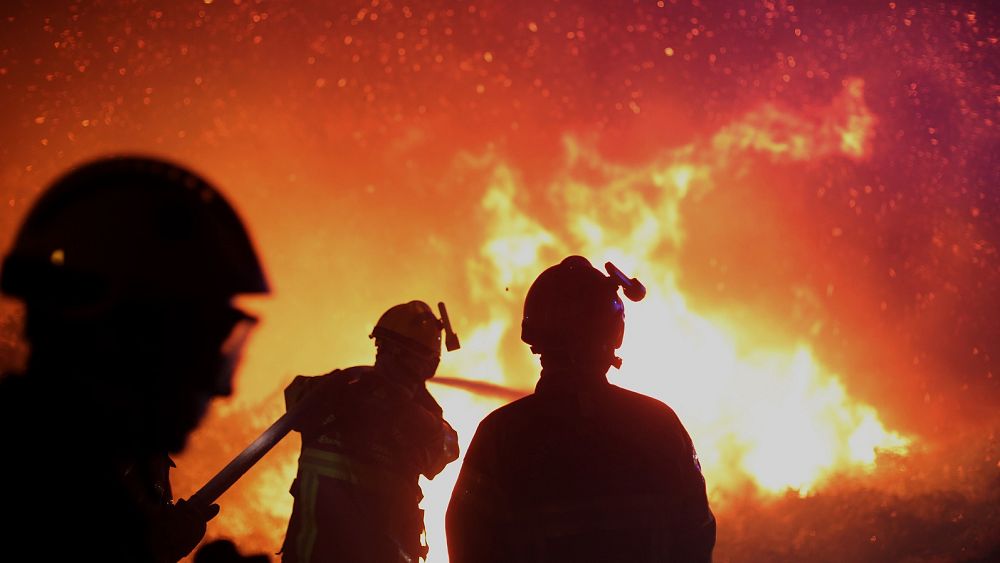The EU is focusing too much on fighting forest fires, experts tell Euronews, and is not addressing the causes properly.
As summer officially started in Europe this week, brand new Canadairs and other fire engines were already deployed in European Union countries, and hundreds of firefighters were ready to fight wildfires.
Forest fire season in Europe is not just upon us, it is already in full swing. Figures well above average already suggest that 2023 could be particularly devastating.
For some, it is proof that the EU’s handling of forest fires is short-sighted, with too much emphasis on emergency services and too little on prevention.
There are also concerns about the slowness of policymakers to tackle air pollution caused by wildfires, despite the fact that it is believed to be far more deadly than the fires themselves.
Spain and France already hard hit
According to European Forest Fire Information System (EFFIS) as of June 18, more than 119,000 hectares had already been burned down in the EU, well above the average of 80,000 hectares recorded at the time for the period 2003-2022.
It took only 31 days for the curves representing the weekly cumulative number of fires and areas burned this year to deviate considerably from the averages of the past two decades.
This despite the fact that nearly a dozen countries, including Greece and Italy – two of the traditionally hardest-hit countries – have below-average numbers. In both countries, the area burned so far this year is just 10% of the averages they normally see at this time of year.
Spain and France, on the other hand, were not so lucky. In France, more than 21,000 hectares have already burned, around 3.5 times the average for the past two decades. In Spain, 66,200 hectares have been lost to 324 fires so far this year – both figures have more than quadrupled.
In a number of central and eastern European countries, the number of fires has also soared, but from very low levels, confirming the trend observed in recent years of forest fires gradually spreading downwards. also north.
Firefighting vs prevention
And this, after more than 830,000 hectares devastated last year – the second worst year since 2006 – the damage caused is estimated at around 2.5 billion euros.
In response, the EU has beefed up its forest firefighting arsenal, this year doubling its firefighting fleet to 28 aircraft based in 10 countries. And for the second year in a row, hundreds of firefighters were deployed to the scene, this time in Greece, France and Portugal.
This is of course to be welcomed, but for Prof. Dr. Johann Georg Goldammer, director of the Germany-based Global Fire Monitoring Center (GFMC), virtually nothing is being done about the root causes.
“At the moment I see almost all governments repeating the same thing that has been done before in southern Europe – they are focusing on firefighting, demanding modern vehicles, planes and participation in the EU Civil Protection Mechanism“, he told Euronews.
“It seems that for politicians, the European Commission and governments, it is a sort of indicator of progress.
“But I don’t see investments to address the root causes of the fires, such as in forestry and land management,” he said.
climate and demographic change
Climate change plays a crucial role in the spread and intensity of wildfires.
According to European Drought Observatory More than a quarter of the EU territory is on drought alert and a further 10% is on alert due to major rainfall and soil moisture deficits.
Added to this is the rise in temperatures. Europe has warmed twice as much as the global average since the 1980s, and last year was around 2.3°C above the pre-industrial (1850-1900) average.
And now the world has had the hottest May and early June on record, with the global average temperature even exceeding 1.5°C in the first week of this month.
All this means that the country is also much drier than normal in large parts of our continent, which favors the spread of wildfires.
But demographic change is also partly responsible. The abandonment of rural areas in favor of urban centers means that the land is no longer exploited in the same way.
Biomass traditionally used for agriculture, heating or other local human activities “is now available for wildfires”, Goldammer told Euronews.
Short-term measures such as preventive burning to reduce combustible biomass in certain corridors can help but are not a panacea.
The GFMC recommended that European governments make rural areas more attractive to younger generations and invest in traditional but also innovative land management to reduce soil flammability.
“Part of the problem is that it takes an awful lot of time. It’s as simple as buying half a dozen planes or ground tanks, investing a few billion and presenting them at a nice press conference,” Goldammer said.
“But investing in local farmers and ranchers to change the flammability of soils takes a long time. It takes years. And success is not easy to measure. It is difficult to prove that a fire has been prevented “, he added.
Where there is fire, there is smoke
The old adage that where there’s smoke, there’s fire also applies the other way around, and it turns out that smoke can be even more dangerous.
“When vegetation burns, a wide range of very toxic and dangerous gases and particles are released, which directly affect local air quality,” explained Mark Parrington, senior scientist at the European Center for Medium Weather Forecasts. term (ECMWF), to Euronews.
According to European Health Observatory PM2.5 air pollution from wildfires across Europe is estimated to have caused 1,400 premature deaths in 2005 and another 1,000 in 2008. For comparison: between 1945 and 2016, 865 people died in forest fires in Greece, Portugal, Spain and the Italian island of Sardinia.
“One of the health effects of this massive air pollution is an increased risk of respiratory and cardiometabolic symptoms,” said Zorana J. Andersen, chair of the environment and health committee. European Respiratory Society, to Euronews. These could lead to serious consequences requiring medication or hospitalization.
“In susceptible patients, these episodes of air pollution can even lead to death. Patients with chronic conditions, especially severe asthma – children and adults – are particularly at risk, as are the elderly, heart disease, pregnant women and people who work outdoors,” she added. added.
While air pollution is highest near the fire, major fires like the ones we’ve seen in France, Portugal, Spain and Greece in recent years can spread air pollution widely. , depending on weather conditions.
In recent weeks, for example, smoke from the current wildfires in Canada has sometimes risen so high that it has been picked up by the jet stream and swept across the Atlantic, Parrington says. At other times, weather conditions have kept the smoke close to the ground, where it is then carried by the wind into major metropolitan areas.
Heat waves continue to deteriorate air quality and worsen pollution, “reminding us that air pollution and solutions to climate change go hand in hand”, added the ERS expert .
“European politicians should urgently pass legislation to further reduce the greenhouse gas emissions that drive climate change. They have a historic opportunity to pass the most ambitious air pollution legislation in the world thanks to the ongoing review of the Air Quality Directive,” she said.
“This would lead to significant reductions in air pollution and associated direct health improvements, while ensuring climate change mitigation, which in turn would have indirect health benefits,” Andersen said. .

Infuriatingly humble pop culture aficionado. Proud beer fanatic. Web lover. Social media fanatic.






